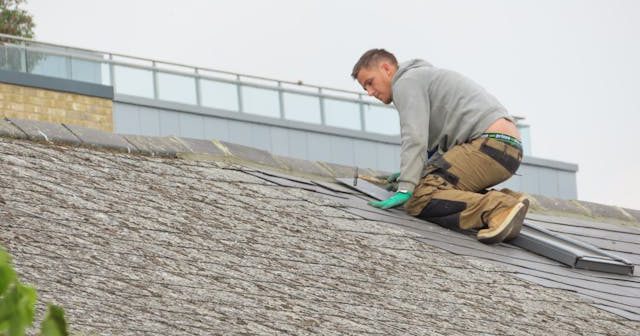Homeowners often delay routine repairs, not out of neglect but because of busy schedules, limited budgets, or simply underestimating the urgency. But deferring minor fixes can turn into major expenses—especially if you’re living in a place like Skagit County. Though the area enjoys a lower cost of living than the Washington state average, it’s still about 55% higher than the national average for families. That means every dollar counts.
What many homeowners don’t realize is that certain annual repairs and inspections are not just “nice to have”—they’re necessary safeguards. A loose shingle, a clogged gutter, or an ignored crack in the driveway might seem minor now but could lead to thousands of dollars in repairs or replacements down the line.
This article outlines eight key annual home fixes that will not only protect your investment but also reduce unexpected repair costs.
- Prioritize Roof Maintenance and Inspection
Your roof shields your home from the elements, and even minor damage can lead to major interior repairs if water makes its way inside. This is especially relevant in Skagit County, where the winters are notoriously wet. Moss, algae, and pooled water can accelerate wear and compromise roofing materials. That’s why an annual inspection is essential. It’s best to hire licensed Skagit roofers who can assess the condition of your shingles, flashing, and underlayment. Professionals have the tools and experience to spot damage early—something that’s often missed by an untrained eye. Preventive roof maintenance might cost a few hundred dollars, but it can save you thousands in repairs or full replacements in the long run.
- Clean and Inspect Gutters and Downspouts
Over the course of the year, gutters fill with leaves, pine needles, and other debris that can block the flow of rainwater. When this happens, water overflows and can accumulate around your home’s foundation. That might not sound like a serious issue, but repeated exposure can cause foundation cracks, mold, and even structural damage. If you live in a tree-lined neighborhood, it’s especially important to clean your gutters at least once a year, ideally in late fall after most of the leaves have dropped. Downspouts should direct water several feet away from the house to prevent erosion and water damage to your basement or crawlspace. Regular inspection and cleaning is a simple step that keeps water where it belongs—away from your house.
- Are Your Windows and Doors Really Closed?
While your windows and doors might be seemingly closed, air leaks through gaps cause your heating and cooling system to work harder to keep your home comfortable. The result is higher utility bills and unnecessary wear on your HVAC system. Annual sealing checks are a low-cost way to improve your home’s energy efficiency. Look for worn or missing weatherstripping, cracked caulking, or any signs of drafts. Replacing or resealing these weak spots is usually a simple DIY task that can make a noticeable difference. Even if your windows are newer, seals can degrade over time, so it’s worth the hour or two it takes each year to inspect and fix them.
- Service Your HVAC System
Your heating and cooling system quietly does a lot of heavy lifting. But without regular attention, it becomes less efficient and more prone to breakdowns. Every year, schedule a professional inspection to clean coils, check refrigerant levels, and inspect ductwork. In the meantime, be sure to replace filters every few months. Dirty filters make your system work harder, which shortens its life and increases energy use.
A well-maintained HVAC unit will keep your home comfortable year-round and help you avoid surprise repair bills, especially during extreme heat or cold when you need it most.
- Inspect Plumbing for Leaks and Corrosion
Water leaks don’t always show up with a dramatic burst pipe. More often, they start with small drips under sinks, behind toilets, or around appliances. These slow leaks can lead to serious damage over time, including wood rot, mold growth, and increased water bills. Once a year, go through your home and check all visible plumbing. Look for corrosion, discoloration, or moisture where it shouldn’t be.
If anything seems off, it’s better to address it now rather than wait for a more expensive failure.
- Clean Dryer Vents and Check Appliances
Most people remember to clean the lint trap in their dryer, but what about the vent that leads to the outside of your home? Over time, lint can build up inside this ductwork, significantly reducing your dryer’s efficiency and creating a major fire hazard. Each year, disconnect the dryer from the wall, clean the vent thoroughly, and remove any debris from the exterior vent cover. While you’re at it, check other major appliances for signs of wear or minor leaks. Refrigerator coils should be vacuumed to improve cooling efficiency. Dishwasher hoses and seals can crack or leak over time, leading to water damage that often goes unnoticed until it’s severe.
Regular appliance checks help you catch issues early and avoid expensive replacements or repairs.
- Test Smoke and Carbon Monoxide Detectors
You might not think about your smoke or carbon monoxide detectors until they start chirping, but these small devices can save lives. At least once a year, go through your home and test each one. Replace the batteries whether they need it or not—it’s a cheap and easy task. Also check the manufacturing date on each unit. Smoke detectors typically need to be replaced every ten years, and carbon monoxide detectors have a slightly shorter lifespan of around five to seven years.
- Check Foundation and Crawl Spaces
Many homeowners rarely think about their foundation unless there’s an obvious problem. Small cracks, shifting soil, and moisture intrusion can develop gradually and silently. Walk around your home each year and look for any new cracks in the foundation or changes in alignment at windows and doors. In crawl spaces or basements, check for signs of pests, moisture, or standing water. Early detection is key. Left unchecked, foundation issues can become some of the most expensive problems to fix.
A home is not simply your shelter; it is one of the greatest investments you’ll ever make. Taking the time to address these annual maintenance tasks helps protect that investment. Just like you schedule an annual checkup with your doctor, your house deserves that same care. A little attention each year prevents major headaches later. Small actions now truly do save you money in the long run.




